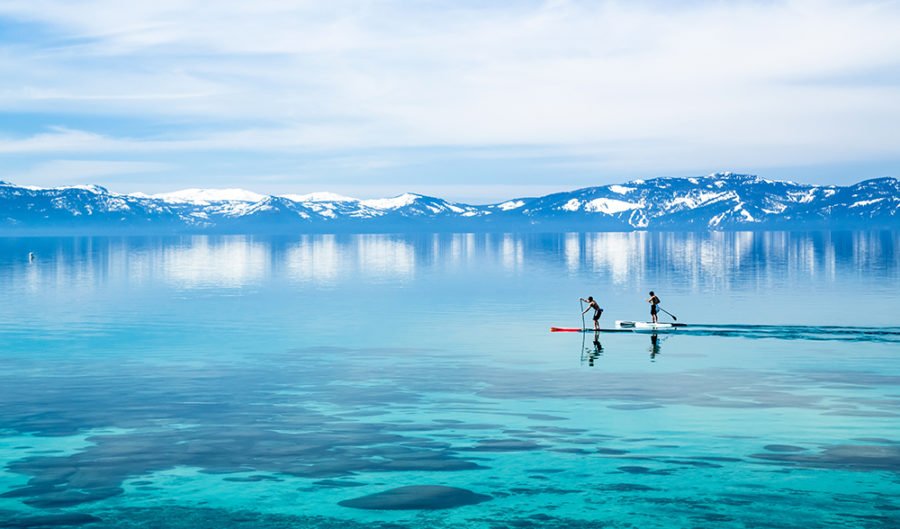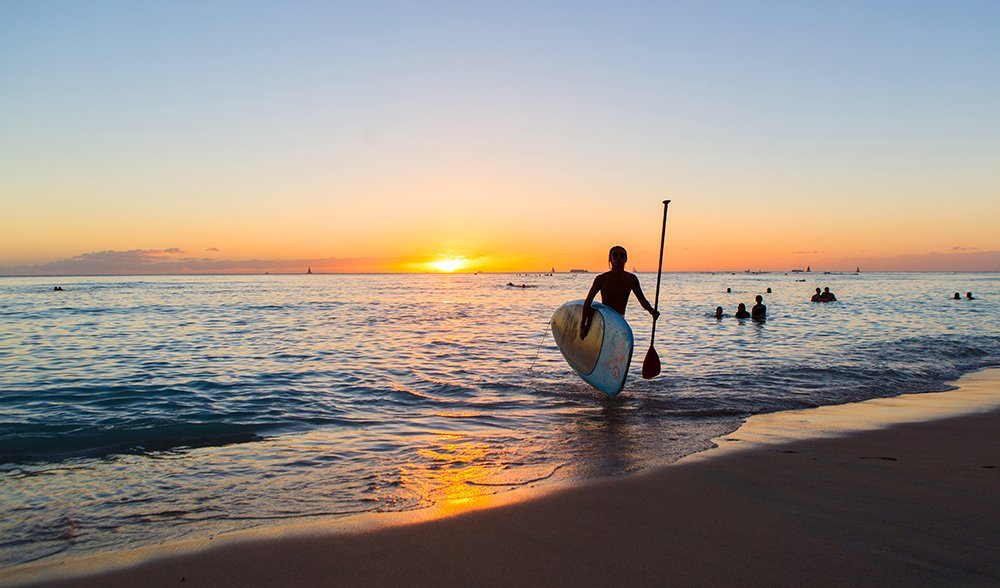Skills: Stand up paddling

STAND UP PADDLE (SUP) is said to have originated in Hawaii in around 2004, although there is some fantastic footage on Youtube of surfing legend Duke Kahanamoku riding a wave while standing astride an Australian surf-ski way back in 1939, so in some ways the sport is not entirely new.
In fact from the early 1950s through to the 1970s, the Waikiki Beach Boys used outrigger paddles on their long boards when they were employed to photograph tourists having a crack at surfing.
The modern interpretation of SUP, however, is said to have first appeared in Hawaii around 2000, when there was an extended period of flat swells, and some dedicated surfers thought it’d be a good idea to get out there on their boards with a paddle to keep fit.
Meanwhile, in Australia, it’s claimed that SUP was up and running as early as 2003, although it didn’t hit the mainstream until the ABC aired a SUP segment on The 7.30 Report in May 2007 featuring surfers Tom Carroll and Richie Lovett, among others. From that point on, SUP was on its stellar growth trajectory, with stand up paddle shops popping up all over the country.
“It’s the fastest growing watersport in the world,” says Nick King from Sunny King Paddleboards. “It’s been like that for a few years, because all the other ones have grown, but last summer in America it rated as the most popular land and sea recreational activity, which is including mountain biking and trekking…”
Nick, who has shaping surfboards for many years, caught the SUP bug about eight years ago and, along with his wife who’s a personal trainer, started Sunny King Paddleboards about six-and-a-half years ago. Nick also competes in ironman events, so he can appreciate the many health benefits offered by SUP, as well as the fun aspect of the sport.
Duke Kahanamoku surfing his paddle board at Waikiki Beach.
Why is SUP so popular?
There are a number of reasons that make SUP popular. “It’s very easy for anyone to do it, there’s no specific demographic of person that does it, so that’s why it’s attractive to so many different people,” Nick King says.
As well as being easy, and a hell of a lot of fun, proponents of stand up paddle reckon it’s the best way to get a thorough, low-impact, cardiovascular workout while having a great time in the water. The combination of balancing and paddling means that you’ll use just about every part of your body, yet the design of the board ensures it’s relatively easy to balance, so it’s suitable for both experienced surfers and those who’ve never even tried surfing before. It’s also suitable for kids, so SUP is a great way to spend a fun day on the water with your family.
“From the cross training side of things, we can [burn] 1200 calories in an hour,” claims Nick King. “And from the paddling side of things, it’s a non-weight-bearing sport, so it’s good for the bigger paddlers and bigger people, because like bike riding and swimming, it’s also easy on your knees and your joints.
“It’s a workout on water. It’s a toes to nose workout; it’s engaging all different muscles that you’re not used to using, but a lot of people are just using it for relaxation and getting out for a bit of a cruise.”
The versatility of SUP also makes it popular. “We do inflatable boards for guys with boats, and we sell them to the navy, and there are all sorts of different guys that are using inflatable boards that you can put into a backpack, and they’re going up to Cradle Mountain, and doing treks and going paddle boarding in places that have never been seen before,” enthuses Nick.
Getting started
Not all stand up paddle takes place in the surf; in fact it’s a very small part of the sport which has split into several different disciplines including, flat-water, touring and competition. There’s even stand up paddle yoga! There’s a range of different stand up paddleboards specifically designed for the sport’s different disciplines, as well as the user’s skill level and experience.
If you’re just starting out it’s a good idea to hire a board and take a lesson or two before you spend up big buying your own equipment. Not only will this be the fastest way to master SUP, it will also ensure you don’t end up with a board that’s too difficult to handle when you’re just starting out, or one that you’ll quickly outgrow as you become more experienced and capable.
The other advantage of taking lessons is that you can avoid picking up any bad habits that can adversely affect your technique. Most SUP schools will offer a range of courses ranging from beginners through to advanced. As well as technique, they’ll also teach you how to stay safe on the water, and advise what sort of board will best suit your needs, depending on how you intend to use it.
There are SUP schools all over the country, so unless you live away from the coast, or in a remote area, you shouldn’t have any trouble finding one. When choosing a school, however, try to speak to people who’ve done a course with them to get some feedback; as with anything, some SUP schools are better than others.

Credit: Shutterstock
The right board
There are a number of factors that should be taken into account when choosing a board. The first is to find one that suits your body size and weight. For starters, the heavier you are the more floatation you will require so to some degree that will dictate the design of board. But the type of paddling you intend to do will have as big a bearing on board selection as the size and shape of your body.
For example, an all-rounder board can be used either on flat water or in the surf, and it will offer a relatively wide platform for good stability in different conditions. For long-distance paddling or exploring, however, it won’t move through the water as easily as a longer, narrower board.
“The main size for people to look at, the biggest seller that we make, is a 10ft 6 board that’s 29 or 30 inches wide, so it’s nice and stable,” says Nick. “It’s still going to hold over 100kg, but for people to get into [the sport], it’s initially nice and stable.”
Weight is also a big factor in choosing the right board. A 10ft 6 board is under 10kg, so it’s going to be easy to throw it up on to the roof of your car, but a bigger board, that’s say 14ft and 12 or 13kg, is not going to be as manageable.
Selecting the right paddle is also extremely important. “The paddle height should be about nine inches above your head height,” says Nick. “About the time the paddle blade is in the water your top hand is around your forehead, so you’ve got quite straight arms, you’re using your major muscle groups, you’re not actually using your arms too much, and it’s all forward of your feet, so you’re engaging all through your obliques and your stomach muscles, and all through your core, and your quads and also your legs, so it’s a good workout.”
Board construction
There are two basic board designs: round-nose boards are usually between 9ft 6 and 11ft 6, and are designed as all-rounders suitable for use on flat water and in the surf; and pointy-nose boards are usually around 12ft 6 to 14ft, and are designed more for flat water paddling and racing.
“Construction wise, we use an EPS core which is expandable polystyrene, which nice and buoyant like a cork,” says Nick. “We still have a wood stringer through the board so it’s nice and stiff and we put carbon reinforcement through the rails, where the impact zones are, where your paddle’s going to be, and your nose and your tail, and also where your foot stance is going to be…”
Some manufacturers make soft boards and also use materials such as plastics instead of fibreglass.
For trekking, inflatable boards are surprisingly robust, and a similar size to traditional paddleboards. “The inflatable ones, for guys with boats, or trekking and travelling and stuff, we’ve got them as a 10ft 6 or a 12ft 6 board,” says Nick. “They’ve got drop-stitching in them so they’re nice and stiff, and they’ve got a three-piece paddle and a foot pump, and a backpack as well, so they can take them anywhere.” Nick claims inflatables can be pumped up in as little as two-and-a-half minutes.
Do it
It’s easy to do, it gives you a great workout and it’s a lot of fun. Oh, and it can also complement other outdoor activities. If you haven’t tried stand up paddle before, perhaps now is the time to have a crack at it.

